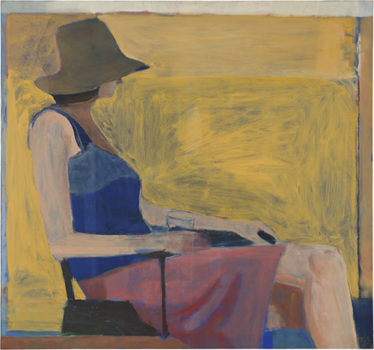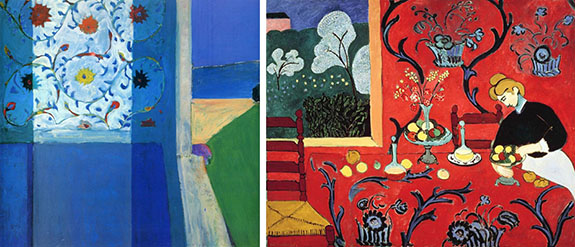
by Lawrence Gipe
In the fall of 1980, my mother dropped me off for my first semester of college at Virginia Commonwealth University. She set up my first ATM card, attached to an account containing $400, which was more money than I had ever been in charge of. Left to my own devices, I went into the VCU bookstore later that afternoon and made the first purchase of my academic career: the catalogue Richard Diebenkorn: Paintings and Drawings, 1943-1976. Needless to say, with fiscal priorities like these, semester one was a financial catastrophe.
Forty years later, compelled to consult this well-worn volume anew, I found side-by-side comparisons of Matisse and Diebenkorn as illustrations in the essay. Diebenkorn never made secret his utter adoration of the French modernist master, so it’s inevitable that scholars would scrutinize this connection thoroughly as part of any serious analysis of the artist’s work. What makes Matisse/Diebenkorn at SFMOMA unique is that it elaborates on this one-sided symbiosis 
Without a doubt, Matisse/Diebenkorn delivers an intriguing narrative of inspiration and obsession: as the curators present it, every time Diebenkorn saw a group or a survey of Matisse’s work (i.e. 1943, 1952, 1960, and the watershed visit to the Hermitage in 1964), his own work ricocheted into new territory. As an art student at Stanford, before his encounters with Matisse, Diebenkorn found inspiration in the work of Edward Hopper (a connection I discussed in 2016 on the occasion of the Cantor Art Center’s presentation of the two artists). “It was the kind of work that just seemed made for me”, the 20-year old reflected, “I looked at it and it was mine.” This infatuation was intense but short-lived. Hopper’s conservative paint handling and brooding urban themes were soon whisked away to the Palo Alto living room of Sarah Stein, which was where, in 1943, that the undergrad saw his first Matisse paintings and drawings. Being related to the celebrated Gertrude and Leo Stein (through marriage to brother Michael) gave Sarah Stein a unique entre 
Diebenkorn was drafted at the end of 1943 and stationed with his wife, Phyllis, at the Marine base in Quantico, Va. It proved to be a fortuitous location. On weekend furloughs the couple combed the East Coast for art museums and discovered the Phillips Collection, located conveniently up the road in Washington, D.C. “Going doesn’t even explain it,” remarked Phyllis, “we’d stay all day.” Its domestic interior and relatively casual ambiance quickly made it Diebenkorn’s favorite (“You could even smoke!” he swooned), and it contained a Matisse painting that he nicknamed “The Big One”: Studio, Quai Saint Michel (1916). The curators pair this work with Urbana #4 (1953). A typical example of Diebenkorn’s AbEx phase, Urbana exhibits as much kinship with de Kooning’s interlocking “Excavation” paintings as it does with Matisse. But it lacks Matisse’s geometry and, of course, the not-so-small detail of content. The only device Diebenkorn derives from Saint-Michel is a scheme for placement of color planes. The central red rectangle of Matisse’s work is clearly mirrored in Urbana. But gleaning other similarities from this contrasting pair might be hard for even educated eyes to detect.

Diebenkorn’s most "revelatory" viewing of Matisse occured in 1964, the Hermitage in Leningrad. Although Diebenkorn never copied Matisse in the way Van Gogh replicated Hiroshige, for example, the paintings executed in the immediate years after this visit demonstrate a searching desire to integrate Matisse’s unique compositional sense and color strategies into his own. A few pictures are a self-described homages, like Recollections of a Visit a to Leningrad (1965), which fuses the intense ornamental patterning of Matisse’s Red Room (Harmony in Red) (1908) with the blue-dominated palette of Conversation (1908-12), two paintings Diebenkorn had never seen in color until 1964.

By 1966, the year Diebenkorn last encountered Matisse — it was at the artist's traveling retrospective at UCLA — even this contrast had evaporated. Diebenkorn took a professorship at that university, forsaking the foggy climes of the Bay Area for the Ocean Park section of Santa Monica. As the French master had done decades before on the Cote d’Azur, Diebenkorn, squinting against the persistent sun, found his own Colliére in Southern California. In the end, Matisse gave Diebenkorn the license to demonstrate that less was more, that tortuous revision was to be avoided. With the Ocean Park series, Diebenkorn offered his audience the “comfortable

armchair” of Matisse of yore. It’s at this point that the chronology of the exhibition sputters out (there are two paintings from the 1980s out of 60 total). In my view, the 25-year long trajectory of this largely unexhibited final work is the most like Matisse in spirit, design and process. A small quibble, as Matisse/Diebenkorn consistently gives us a sumptuous chronicle of a captivating (albeit one-sided) relationship.
# # #
“Matisse/Diebenkorn” @ SFMOMA through May 29, 2017.
About the author:
Lawrence Gipe is an artist, art professor and writer. His painting and drawings have been shown in more than 50 solo exhibitions in the U.S. and Europe. Gipe, along with his collaborator, Sarah Tell, was a curator-in-residence this spring at Pro Arts in Oakland, where the exhibition, Everyone is Hypnotized: Artists Dérive the Bay Area, opens this month.